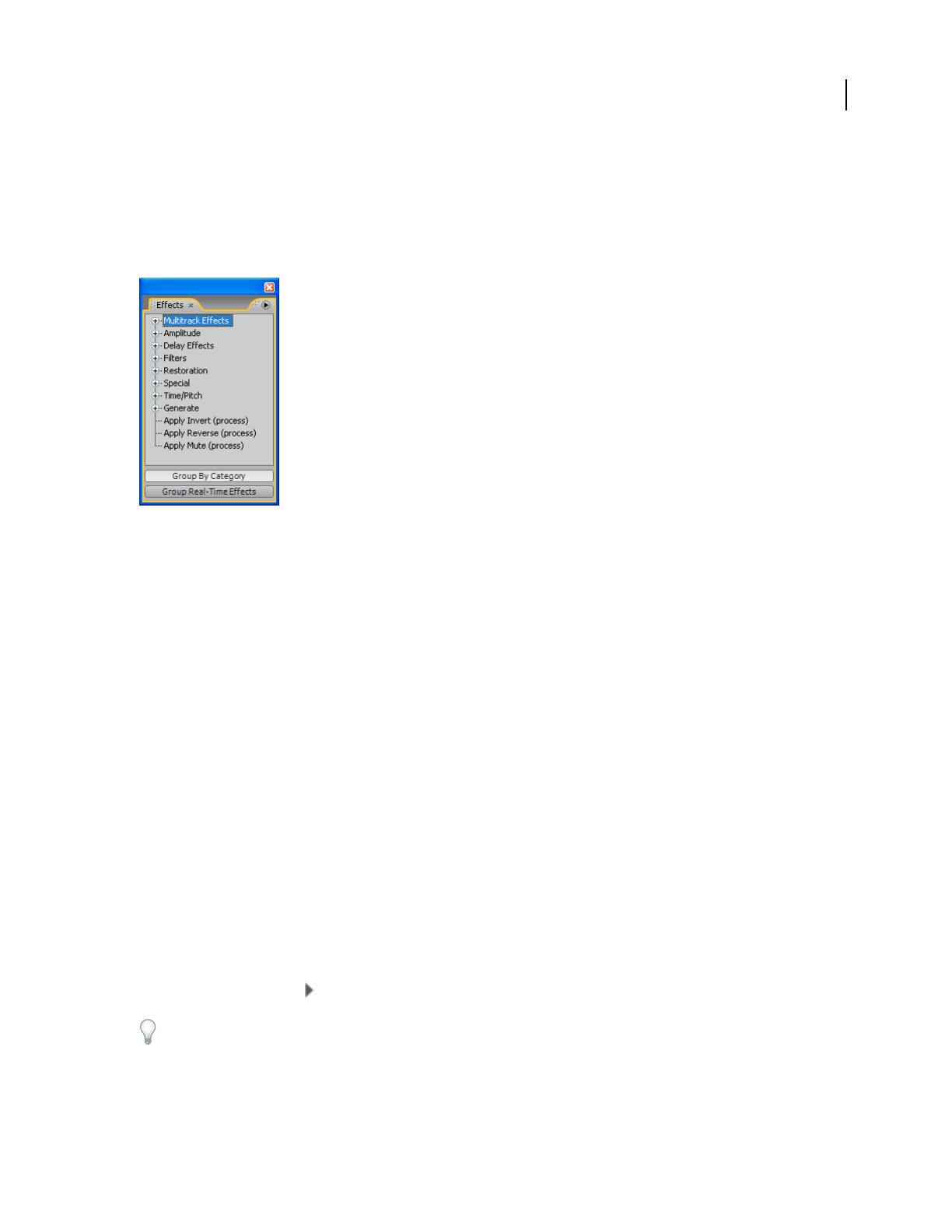Operation Manual
Table Of Contents
- Contents
- Chapter 1: Getting started
- Chapter 2: Digital audio fundamentals
- Chapter 3: Workflow and workspace
- Chapter 4: Setting up Adobe Audition
- Chapter 5: Importing, recording, and playing audio
- Chapter 6: Editing audio files
- Displaying audio in Edit View
- Selecting audio
- Copying, cutting, pasting, and deleting audio
- Visually fading and changing amplitude
- Working with markers
- Creating and deleting silence
- Inverting and reversing audio
- Generating audio
- Analyzing phase, frequency, and amplitude
- Converting sample types
- Recovery and undo
- Chapter 7: Applying effects
- Chapter 8: Effects reference
- Amplitude and compression effects
- Delay and echo effects
- Filter and equalizer effects
- Modulation effects
- Restoration effects
- Reverb effects
- Special effects
- Stereo imagery effects
- Changing stereo imagery
- Binaural Auto-Panner effect (Edit View only)
- Center Channel Extractor effect
- Channel Mixer effect
- Doppler Shifter effect (Edit View only)
- Graphic Panner effect
- Pan/Expand effect (Edit View only)
- Stereo Expander effect
- Stereo Field Rotate VST effect
- Stereo Field Rotate process effect (Edit View only)
- Time and pitch manipulation effects
- Multitrack effects
- Chapter 9: Mixing multitrack sessions
- Chapter 10: Composing with MIDI
- Chapter 11: Loops
- Chapter 12: Working with video
- Chapter 13: Creating surround sound
- Chapter 14: Saving and exporting
- Saving and exporting files
- Audio file formats
- About audio file formats
- 64-bit doubles (RAW) (.dbl)
- 8-bit signed (.sam)
- A/mu-Law Wave (.wav)
- ACM Waveform (.wav)
- Amiga IFF-8SVX (.iff, .svx)
- Apple AIFF (.aif, .snd)
- ASCII Text Data (.txt)
- Audition Loop (.cel)
- Creative Sound Blaster (.voc)
- Dialogic ADPCM (.vox)
- DiamondWare Digitized (.dwd)
- DVI/IMA ADPCM (.wav)
- Microsoft ADPCM (.wav)
- mp3PRO (.mp3)
- NeXT/Sun (.au, .snd)
- Ogg Vorbis (.ogg)
- SampleVision (.smp)
- Spectral Bitmap Image (.bmp)
- Windows Media Audio (.wma)
- Windows PCM (.wav, .bwf)
- PCM Raw Data (.pcm, .raw)
- Video file formats
- Adding file information
- Chapter 15: Automating tasks
- Chapter 16: Building audio CDs
- Chapter 17: Keyboard shortcuts
- Chapter 18: Digital audio glossary
- Index

ADOBE AUDITION 3.0
User Guide
106
Group effects in the Effects panel
The Effects panel lists all available audio effects for easy access. You can change the grouping of effects to best meet
your needs.
In addition to Adobe Audition effects, you’ll find any third-party DirectX plug-ins on your system, plus VST plug-ins
in specified folders. (See “Enable VST effects” on page 110.)
Effects panel
❖ Click the buttons at the bottom of the Effects panel:
Select Group By Category To list effects in a hierarchy where categories and their entries are shown in the same order
as they appear in the Effects menu.
Deselect Group By Category To display all effects in roughly the same order as they appear in the Effects and
Generate menus.
Select Group Real-Time Effects To list effects in a hierarchy where all of the Real-Time Effects are grouped together,
the Off-Line Effects are grouped together, and the Multitrack Effects are grouped together.
Deselect Group Real-Time Effects To return to the previous view.
Applying effects in Edit View
Apply groups of effects in Edit View
In Edit View, the Mastering Rack lets you apply groups of effects. (It doesn’t provide process effects such as Noise
Reduction, which must be applied individually.)
1 Select the desired audio with the Time, Marquee, or Lasso Selection tool. (Double-click to select the entire file.)
2 Choose Effects > Mastering Rack.
3 In the FX list, choose effects for up to 16 slots.
4 Click the Preview button , and then edit, mix, and reorder effects as needed.
Tocompareprocessedaudiotooriginalaudio,selectanddeselectthemainPowerbuttoninthelowerleftcornerof
the rack, or the Power buttons for individual effects.
5 When you’re ready to apply the changes, click OK.










